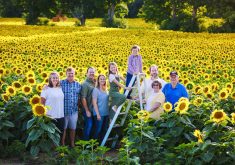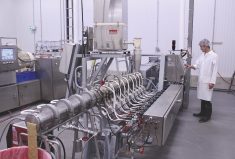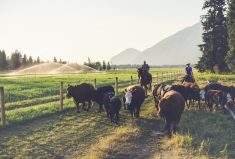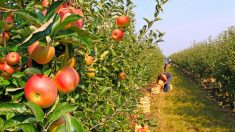At Prairie Gardens & Adventure Farm a half hour north of Edmonton, 80 per cent of the family’s farm revenue used to come from commodity sales and 20 per cent from agri-tourism. Now, those numbers have flipped with agri-tourism bringing in the bulk of the revenue for their northern Alberta farm.
Owner Tam Andersen says their roots remain firmly in agriculture. Farming is something she loves.
So why has Andersen made tourism their core enterprise, and farming the platform from which it operates. Well, it’s business.
Read Also

What to consider when setting up farm-related business ventures
Things to consider before launching a farm-adjacent side business.
“We generate more revenue from a very small farm than we could ever hope to on a purely agricultural basis,” Andersen says.
Ironically, switching out of full-time farming is what will make it possible for the farm to grow, and for it to be sustainable for future generations.
[READ MORE] And even more on the way
Slow and steady diversification
Today, Prairie Gardens & Adventure Farm succeeds by firing simultaneously on a fantastic number of cylinders, but when Andersen began farming almost 40 years ago and joined the family operation, it had only begun taking advantage of its proximity to Edmonton, adding a tree nursery and a garden centre, and growing vegetables for the wholesale market.
Profits from selling wholesale were low, though, and Andersen admits she didn’t enjoy growing for the wholesale market, but that only drove them to try new ventures, and things clicked much better when they tested pick-your-own fruits and vegetables. She says she enjoyed being able to connect person-to-person with customers and to see the wonder on people’s faces as they picked the fresh crops.
Then, moving into agri-tourism seemed a natural evolution for Prairie Gardens. With the natural beauty of the property, Andersen says customers would ask her what else there was to do at the farm. She says the family listened carefully, and what they heard was their customers telling them they were yearning for a meaningful connection with the people who grow their food, which further drove their expansion and diversification.
The farm now has 60 acres of heirloom and specialty fruit and vegetables in production — 25 at the home farm and the remainder on newly purchased land down the road. They grow flowers and tomatoes in the greenhouse in the spring; have U-pick strawberry and pumpkin patches; specialize in northern fruit trees; host school tours, forest walks, a pumpkin festival and on-farm dinners; and operate a petting zoo, weekly CSA vegetable subscription and on-farm store.
Prairie Gardens is especially known for their pumpkins. Not only is it unusual to grow pumpkins this far north, they grow a wide range of varieties including blue culinary pumpkins, explains Andersen. Growing pumpkins with their short season means being innovative. The mature pumpkins, which don’t tolerate temperatures below -5 C, are stored in the same greenhouse that is used to grow flowers in the spring. Then that greenhouse is used to overwinter fig trees which also makes a lovely setting for on-farm dinners.
Being business savvy means they’ve kept to a manageable pace of expansion so that, with a few successful grant applications, it’s been possible to expand without taking on extra debt beyond their usual operating loan.
Collaboration
It hasn’t all been easy. Disputes with the county about roads and safety have been contentious, expensive and distracting, but in other contexts Andersen sees networking as key to achieving their goals and she is constantly on the lookout for ways to collaborate with others. Some of these opportunities develop naturally; others come together because she seeks out others for mutually beneficial ventures.
It was through selling their high-quality produce to restaurants in Edmonton that they developed relationships with chefs. By working with the Edmonton tourism department, which has a strong focus on culinary tourism, they began partnering with these chefs to offer pop-up dinners at the farm which feature their products. This has evolved into hosting regular Long Table dinners led by their own in-house chef using their own inspected kitchen.
Another opportunity to collaborate arose when the closest town, Bon Accord, became Canada’s first international Dark Sky Community. Only five minutes away from the farm is a gin distillery which makes Dark Sky gin. Prairie Gardens now offers a dinner at the farm which creates an opportunity for guests to view the aurora borealis or starry night sky while sampling this award-winning gin.
By working with Travel Alberta, the provincial tourism ministry, the farm has moved into international tourism, attracting visitors from the United States, Germany and Japan.
The tipping point
While Andersen had been diversifying and expanding the farm’s tourism offerings for years, a workshop sponsored by the Alberta and Edmonton tourism departments a decade ago was transformational.
Andersen says the workshop, which was facilitated by sustainable tourism consultant Celes Davar, was a tipping point that shifted her perspective and helped her recognize the farm’s full potential by seeing it through fresh eyes.
She credits Davar with helping her to see the value of their farm story and that they could monetize that value in a new and diverse income stream that could help make the farm sustainable. “As farmers, we don’t always appreciate our day-to-day experiences on the farm,” Tam says.
Through the workshop she learned how to optimize the rhythm and flow of an experience and how to immerse visitors in the experience so they could connect with all of their senses and “participate the same way we do as farmers.”
Andersen says the shift has meant moving away from a high volume-low return model to a low volume-high return model that is more sustainable. She shares some examples of how this looks on their farm.
In the past, they charged a $9 general admission to the farm which included the petting zoo. Now, families pay $25 for 30 minutes of one-on-one time with the animals.
The demand for their cold-hardy fruit trees and berry bushes is up due to heightened concerns about food security brought on by the pandemic. Instead of selling individual trees, they now offer a range of packages which include a mix of hardy fruit trees and shrubs along with their knowledge on how to grow the fruit successfully. As a result, spring revenue has increased by a factor of almost 30 from an average of $53 to $1,500 per person.
VIP helicopter tours have been another value-added addition to the farm’s offerings. Visitors arrive via helicopter for a tour of the farm from the air followed by a tour on the ground where they learn the farm’s stories.

Challenges
The farm is north of the 56th parallel and, not surprisingly, the weather is their biggest challenge, says Andersen. “We farm with one eye on the sky and one on the thermometer.” However, the diversity of the farm operation does build in some resilience to bad weather with the different aspects of the business complementing one another and making better use of the farm’s resources.
Andersen, meanwhile, works with a core staff of four people year-round, which expands to 50 during their pumpkin festival. Adding events throughout the year fills the gaps so she can keep her staff busy. Her core team members tend to come to her because they want to be a part of something meaningful. Often, it’s their second or third career.
In addition to cultivating plants, she sees her role as cultivating people. Everyone is valued for their skills, she says, adding that she tries to bring out those unique skill sets.
Her daughter, Laurel, who speaks multiple languages, is bringing her own interests into the operation. Passionate about heritage chicken breeds, she has added a Rustic as Cluck Farm Tour to their agri-tourism offerings.
The farm also now has an elder-in-residence who shares the Indigenous perspective. Andersen says it has been very eye-opening and rewarding to work with an elder on their Treaty 6 lands.
“As colonial farmers, we are so humbled and amazed to be part of that process,” Andersen says.
In the old growth boreal forest on their farm, they have created the Turtle Island Trail and received a designation as a certified National Healing Forest, a dedicated space for healing, learning, sharing and reflection about Canada’s history and the legacy of Indian residential schools.
While venturing into agri-tourism has improved the farm’s sustainability and it is supporting the family’s goal of being able to pass the farm on to the next generation, Andersen emphasizes that it works because it all comes from “a place that is genuine.”
This is important for her, and it’s important for the business. In fact, it’s a key success factor. Anderson knows she loves to grow things, but it’s also crucial that she also loves to share this experience and to talk about the farm with visitors.
In the process, those visitors see that her love for growing food is authentic and genuine. “People connect to that,” Andersen says. “They can see it, taste it, and hear it in the stories of the farm.”
What does it take to win with experiential tourism?
Below, Tam Andersen shares key learnings from Prairie Gardens & Adventure Farm:
1 Commit to learning and growing all the time. Andersen seeks educational opportunities through local and provincial tourism offices and producer associations. She travels to intensive boot camps organized by the North American Farmers Direct Marketing Association and her family trips revolve around agri-tourism experiences.
2 Embrace the idea that visitor expectations have shifted. “Consumers are concerned about climate change and yearn to know where their food comes from. They want to be part of something positive for themselves, their families and the planet.”
3 Investigate the permitted uses for your farm. “This varies widely across the country.”
4 Connect with government tourism offices at the municipal, provincial and federal levels.
5 Think about transportation. How will visitors get to your farm? Where will they park?
6 Assess risk and ensure you have the right liability insurance policy to welcome guests to the farm.
7 Adapt and learn, especially as a manager. You can’t manage in fits and starts. It’s a “day in, day out commitment,” Andersen says. But also, never forget that it takes flexibility too. For her farm to succeed, she says, she must be “like a willow in the wind that bends but doesn’t break.”
















